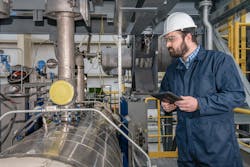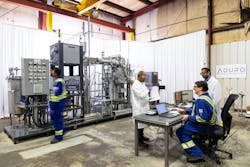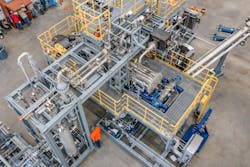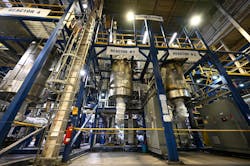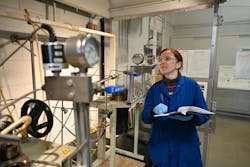Key Highlights
- Emerging technologies like depolymerization and pyrolysis are gaining ground alongside mechanical recycling to handle difficult waste streams.
- Industry experts emphasize the importance of combining different recycling methods to maximize recovery and address the 90 percent of plastics not yet recycled.
- Investment in advanced recycling is increasing, with petrochemical companies and startups expanding capacity and developing new facilities.
- Federal funding cuts have slowed some projects, highlighting the need for policy stability and incentives to support industry growth.
- Demand for sustainable plastics and circular economy initiatives is expected to drive technological adoption despite current economic and logistical challenges.
By Karen Hanna
With plastics recycling rates long stuck around 9 or 10 percent, emerging technologies that include depolymerization, pyrolysis and chemical processes are finding a niche alongside mechanical recycling, as the industry struggles to meet consumer demand for sustainability. But when it comes to scaling up, recycling experts acknowledge some hurdles — including funding uncertainties, the low cost of virgin materials and the failure to centralize recycling policies.
So far, reality hasn't matched stated expectations for capacity, as adoption of advanced recycling technologies has come in fits and starts, but proponents expressed optimism regarding where they’re headed.
“The ultimate goal shouldn’t be to push one method over another, but to find the right solution to recycle each material. Mechanical and advanced recycling should be synergistic technologies allowing for an increase in the quantity of material that is recyclable/recycled versus those that are not. This may involve changing the materials we use in society, or, in our case, looking for new ways to process the materials we do not [use] currently,” said Ben Scott, director of research and innovation at GreenMantra Technologies, Brantford, Ontario, which uses molecular recycling to transform hard-to-recycle PE and PP into waxes and polymers.
Rather than presenting competition vs. traditional recyclers, representatives of companies — like Scott's — that are developing new options said they see their technologies as alternatives to simply dumping waste that’s too dirty or heterogeneous to handle any other way.
They’re ready to make their mark on unrecycled waste.
“Our technology's been running for 15 years plus on various feedstocks. The technologies are much more advanced than they were a decade ago, ours included, and they're ready for commercialization and are being commercialized,” said Chris Faulkner, CTO of Agilyx, Tigard, Ore., an investment platform that manages several plastics-related companies.
Closing the plastics circle
Packaging, agricultural and flexible films, colored bottles — the kinds of plastics mechanical recyclers don’t want seem ubiquitous, as you’re standing at the bin making the decision: Recycle or trash?
Too often, the answer is trash.
“Advanced recycling, on the other hand, can handle mixed or difficult-to-recycle materials — streams that historically posed challenges for mechanical recyclers. By working in tandem, these processes can maximize recovery, reduce landfill volumes and address gaps in today’s recycling infrastructure,” said Andy Brewer, director of recycling and sustainability for the Plastics Industry Association (PLASTICS).
Faulkner said his company’s sights are on the 90 percent of plastics that are not currently recycled.
Can advanced recyclers really pick up all that slack?
“That's an aspirational goal,” Faulkner said. “If we're all committed to it, I think we can get there a lot quicker.”
Eric Appelman, who has worked in chemistry for 40 years, is also eyeing those numbers.
Now the chief revenue officer for London, Ontario-based Aduro Clean Technologies, Appelman said economics alone underlie the urgency to boost recycling numbers. In his native Netherlands, there’s simply not enough room to landfill everything — and no natural resources to replace the plastics that are trashed.
Scaling up is critical to making recycling profitable.
“I think in Europe, very significantly, the authorities have realized that mechanical recycling on its own cannot do the job. It is just addressing too small a fraction to be totally meaningful. And, as a matter of fact, if you only address that small fraction, you are not going to generate revenue to pay the bill for collecting the whole fraction,” he said.
But, he and Faulkner stressed, time is an important part of the equation.
Mechanical recycling has enjoyed a head start. And the chemicals industry that makes plastics has even longer roots.
That has left the nascent advanced recycling industry in a hurry to catch up, at a time when the plastic waste problem is commanding attention.
“There's a scale imbalance in the waste industry vs. the chemical industry,” Faulkner said. “We have become very proficient over the past 150 years at producing chemicals. The facilities are massive and waste is very distributive. You make those polymers in a concentrated area, then we disperse them globally. And now we're aiming to do the opposite.”
Compared to the chemicals industry, there is a long way to go. Faulkner said he expects chemical recycling to represent just 2-10 percent of the scale of traditional virgin resin manufacturing, but, he said, “that's not unexpected for new industry technology.”
But the speed of the chemicals industry’s evolution also could be a template for people looking to advance recycling.
"Whereas you might look at crude oil as a big, black, dirty mix; it is actually, after 100 years of learning, a pretty transparent and manageable feedstock. We have only started with just scratching the surface,” Appelman said.
State of investment in advanced recycling
Ramp-up of advanced recycling technologies has taken an uneven path, and recycling experts provided mixed assessments of the current state of expansion and investment within the industry.
PLASTICS’ Brewer described a “steady rise in capital investment aimed at expanding facility capacity and increasing material output” and said: “Advanced recycling is expanding rapidly, with new facility capacity being added each year to improve overall recycling rates. Investments continue to accelerate, driving the development of innovative technologies and scaling operations.”
Citing data from ICIS, a market pricing and analysis firm for the chemical and oil industries, and PureCycle, which uses a purification, or dissolution, process — rather than a chemical reaction — to transform waste plastic, Scott Trenor, technical director for the Association of Plastic Recyclers (APR), quantified input volumes of various recycling methods this way:
- Gasification — 40,000 tons;
- Pyrolysis—90,000 tons;
- Depolymerization — 160,000 tons (all Eastman)
- Dissolution — 49,000 tons
Overall, mechanical recycling produces an output of 2.5 million tons of material.
“So, if the chemical recyclers were 100 percent efficient, at best they'd be at 10 percent of recycled plastics,” he said.
Currently, though, citing a third source, Trenor said, “Plastics Europe has chemical recycled plastics at approximately 1 percent of all recycled plastics on the market.”
According to an article on the topic that was recently submitted to Plastics Machinery & Manufacturing by ICIS, most projects are in early stages, with limited capacity.
Some companies are spinning their wheels with pilot projects, according to Trenor.
“Even as investors remain cautious, given the interest that is swirling around these spaces, the startup and expansion landscape begins to heat up,” wrote ICIS article authors Andrea Bassetti, Americas team lead, plastics recycling; Corbin Olson, senior analyst, plastics recycling; and Joshua Dill, analyst, plastics recycling.
Petrochemical companies, startups make headway
Some companies are moving ahead with advanced recycling projects.
Among the biggest players in the segment are petrochemical companies that are also involved in manufacturing virgin resins. But they’re not alone — other, smaller companies, such as Revalyu and GreenMantra, also are elbowing for position.
Petrochemical companies have an advantage of scale, Trenor explained.
“Petrochems are orders of magnitude larger than most mechanical recyclers and can support large investments, although they may not actually. In terms of collaborations, there are examples of chemical recyclers sending their waste streams to chemical recyclers. Some petrochems like LyondellBassell [LYB] and Dow are scaling both simultaneously. LYB has mechanical, physical (dissolution) and pyrolysis capabilities and must split feedstocks to feed all three. Similarly, Dow has mechanical recycling assets, [is] working to scale dissolution of PE as well as joint projects with Mura on hydrothermal chemical recycling.”
In June, ExxonMobil Chemical Co. announced it’s doubled its capacity at its plant in Baytown, Texas, where, as of the previous month, it had processed more than 50,000 tons of plastic waste, with a recovery rate of nearly 90 percent. It’s planning to add two additional units at the facility, along with a unit in Beaumont, Texas, and it is eyeing other sites, as well.
It’s looking to eventually have a capacity of around 250,000 tons of plastic waste a year.
“By embedding these units within our pre-existing facilities, we can scale up faster and at a much lower cost than most of industry, and we can help increase recycling rates in nearby cities and towns,” it said.
One nonpetrochemical producer looking to seize on business opportunities is Revalyu, which expected to open an glycolysis plant for PET this fall in Statesboro, Ga. In an 2023 announcement of the project, it stated it was investing more than $200 million and targeting an annual capacity of 100,000 tons.
It touted a process it’s already implemented in India to produce recycled PET [rPET], and said in statement, “Compared to conventional PET, revalyu’s rPET is produced using 75% less water, 91% less energy, and saves around 0.7 barrels of oil and 0.2 cubic meters of landfill space per 2000 pounds of PET recycled.”
GreenMantra also is celebrating expansion, after last month receiving its third loan in the last decade from Closed Loop Partners, an investment firm that provides funding for circular economy solutions. The $10 million will help it expand its facility and increase its material processing.
Scott said the loan comes after the Canadian government announced earlier this year it was making a $3.8 million investment.
According to a Closed Loop Partners press release, GreenMantra expects to increase its output of its recycled products — which include specialty waxes that can be used in the building and road construction industries — by approximately 50 percent.
“This financing marks a significant acceleration in our work to scale solutions that help ensure hard-to-recycle materials do more for our planet,” GreenMantra CEO Domenic Di Mondo said.
Meanwhile, according to Appelman, Aduro is building a second pilot plant, bringing its recycling capacity to several hundred tons of plastics a year.
Every year, Agilyx handles about 20 million tons of mixed feedstock made up of PS and styrene-related products.
Roadblocks to implementation
Not all projects are making as much progress.
One source of trouble is the federal government, which has undertaken dramatic cuts since the start of President Trump’s second term.
“Federal grants have been a driver in helping advanced recycling technologies move into commercial-scale operations. When that funding is withdrawn, it slows the time to commercialization,” PLASTICS’ Brewer said.
In comments posted on LinkedIn, Mitch Hecht, the founder and chairman of the now-defunct International Recycling Group, explained his company's end, after last year it landed a $182 million contract from the U.S. Department of Energy to build in Erie, Pa., what he had envisioned as “the world’s largest plastics recycling plant to process all types and grades of plastic scrap.”
“Unfortunately, following the inauguration of a new Administration, that loan commitment was placed on hold by Presidential Executive Order as part of a broader pause and review of federal loan guarantees and clean energy financing programs. This abrupt change in federal policy had a severe and immediate impact on our ability to move forward,” he wrote.
Related content
Related content
ICIS predicts moderate growth and expanding capacity in years to come. Read their analysis.
Total cost of the project would have been about $300 million, according to Trenor.
The grant’s cancellation was one of scores announced during the early days of the Trump administration. At one point, in May, the DOE announced 24 grant cancellations totaling over $3.7 billion.
Eastman Chemical Co., which planned the second of two methanolysis plants to recover value from PET sources that often aren’t recycled — including polyester trays, colored and opaque bottles, and fabrics — reported to its investors that it had lost a grant worth up to $375 million to fund the project in Longview, Texas.
According to a company report before the grant termination, “The facility plans to use thermal energy storage combined with on-site solar power to decarbonize process heating operations, resulting in a product with 70% lower carbon intensity compared to fossil virgin PET.”
While grant losses impacted the IRG and Eastman projects, Trenor said, “Others, I believe, are struggling on process and economics.”
Meanwhile, for Aduro Clean Technologies, investment in the U.S. is a ways off.
Its approach might be better characterized as slow and steady.
“We have not been investing big time in the U.S. You do see investments in the U.S., in the pyrolysis technique,” Appelman said.
What’s ahead for advanced recycling?
Speaking just a few weeks after Global Plastics Treaty talks collapsed, and with U.S. funding undergoing significant shifts, the recycling experts said they saw both reasons for optimism, as well as challenges, as advanced recycling scales up.
In the end, they believe demand for sustainability will drive recycling.
“The U.S. has definitely changed some policies in the past six months, and the industry is working through that, but the demand is still there, regardless of political whims,” Faulkner said.
But Trenor said it remains to be seen how the various recycling processes shake out.
“While the process basics are understood, the economics are not yet proven,” he said. “Plastics made via chemical recycling will continue to be challenged by the lost cost and oversupply of virgin fossil fuel-based plastics just like mechanically recycled plastics currently are.”
He pointed out one chokepoint on recycling expansion: Feedstock.
“In theory, there should be plenty of material to feed all recycling processes. In practice, APR's most recent study has North American mechanical recyclers running at about 5.2 billion [pounds per] year, yet have an additional 2 billion [pounds[ of excess capacity. Everyone will compete unless we expand collection and look at recycling items beyond packaging,” he said.
Incentivizing collection would represent an important step, said Aduro’s Faulkner, who like Appelman, supports Extended Producer Responsibility arrangements that would help subsidize recycling through levies on products that incorporate problematic materials.
Passing on a cost for products’ environmental impact throughout their lifespan would not only raise money for the recycling, but also help raise awareness of the environmental implications of every purchase.
Such a system might help prices for recycled resin better compete with virgin resin, Appelman said.
“The reason why it is cheaper is that there is overcapacity. ... That is a supply-and-demand matter that will typically sort itself out over time and, but also the processes to make virgin plastics are incredibly efficient. The scale is absolutely stunning, and the technology is wonderful. And, yes, it is efficient. Now, partly, it is also efficient because we don't put the right price [on it], and we have to,” he said. “If we are agreeing that carbon dioxide in the atmosphere from fossil sources is bad, we should give it a price.”
To further boost advanced recycling, Trenor said his organization and others are working to have the processes viewed on par with mechanical recycling. In some states, such as New Jersey, packages that use materials derived from advanced recycling processes can’t include a claim of being made from recycled material.
That affects consumer perceptions, Trenor said.
Trenor pointed out that once materials are picked up, another consideration is sorting and distributing them to the recyclers that use the process that would prove most beneficial.
Some materials, such as flexible PP, contaminated medical packaging and electronics waste, could be earmarked for chemical recycling, Trenor said.
In the case of multi-material packaging, though, he said specifications and tolerances could vary based on the recycling stream and particular process.
“What I believe is absolutely essential is that you optimize the whole thing, that you also do not limit yourself to one recycling technology, because if you can mechanically cycle, it is always the best from an energetic perspective,” Appelman said.
Even the design of a product should be re-assessed in considering its end-of-life, according to Appelman, who expressed concern about the use of a handful of “show-stopping chemicals” and materials — like PFAS and PVC — that present risks to the environment and obstacles to recycling.
But even with the challenges ahead, in his decades-long career, he said he’s rarely seen any project move so fast.
"There's still work to be done, and there is scale advantages and all that sort of thing. I'm convinced that we can get there, but it takes time, and we shall not rest on our laurels."
Glossary
Advanced recycling techniques involve breaking down plastics with solvents, chemicals or enzymes, or using heat or even sound waves to break down plastics into liquid or gaseous polymers, monomers, oligomers or hydrocarbons that can return to manufacturing supply chains.
Plastics recycled in this way are impractical to recycle through mechanical means. They include films, layered packaging and mixed plastics.
Products from advanced recycling technique can be reused in virgin-quality plastic that’s even appropriate for food, medical and pharmaceutical packaging applications.
The following definitions are based on information from the American Chemistry Council Inc.; Closed Loop Partners, a New York firm that invests in circular economy initiatives; chemicals company Dow; Plastics Recyclers Europe; and the U.S. Energy Information Administration.
Chemical recycling Another term for advanced or molecular recycling, referring to the conversion of plastics to their molecular building blocks.
Depolymerization Unzipping specific polymers, such as PET, back into monomers.
Dissolution The use of a solvent to separate polymers from waste and without changing their chemical nature.
Gasification A chemical conversion process that converts hydrocarbon feedstocks into a synthetic natural gas product, called syngas, in the presence of a small amount of oxygen that is less than what would be needed for combustion. The syngas can be used as a chemical feedstock to produce other materials.
Hydrocracking unit A process that takes gas oil, which is heavier and has a higher boiling range than distillate fuel oil, and cracks the heavy molecules into distillate and gasoline in the presence of hydrogen and a catalyst.
Mechanical recycling The processing of plastics waste into secondary raw materials or products without significantly changing the chemical structure of the material. This results in a lower-grade material.
Molecular recycling Another term for advanced or chemical recycling, referring to the conversion of plastics to their molecular building blocks.
Pyrolysis A thermal process that involves heat — generally less than 800 degrees Fahrenheit — to break down plastics in the absence of oxygen. It is distinguished from incineration, which uses oxygen and produces no viable end products.
Pyrolysis oil Also known as pyoil, this is a product of pyrolysis that contains hydrocarbons derived from fossil fuels. With further processing, these fractions can be separated by molecular weight to create the building blocks for plastic, chemicals, waxes, lubricants and other materials. Pyoil, oil and natural gas can be used in similar ways.
Styrene monomer A chemical building block that’s used to create numerous plastic products and synthetic rubber.
About the Author
Karen Hanna
Senior Staff Reporter
Senior Staff Reporter Karen Hanna covers injection molding, molds and tooling, processors, workforce and other topics, and writes features including In Other Words and Problem Solved for Plastics Machinery & Manufacturing, Plastics Recycling and The Journal of Blow Molding. She has more than 15 years of experience in daily and magazine journalism.
